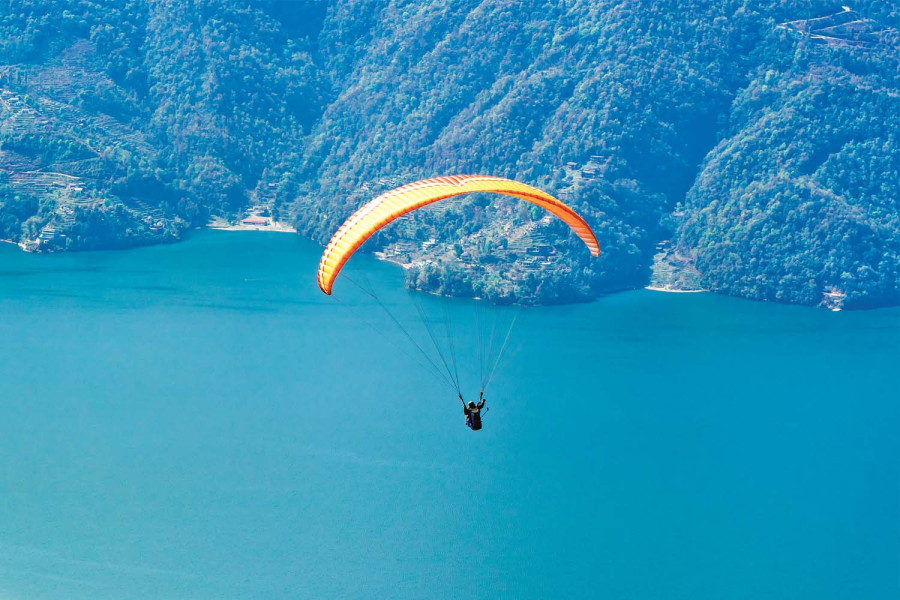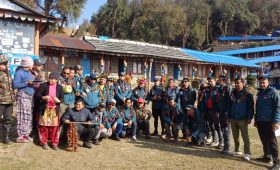MONEY
Recovery taking longer than expected
Pokhara tourism has been trying to bounce back from the Covid-19 disaster. But it has been tough going. Investors have poured billions into Pokhara’s tourism, mainly the hospitality industry, and the slowed arrivals have worried everyone. Shutterstock
Investors have poured billions into Pokhara’s tourism, mainly the hospitality industry, and the slowed arrivals have worried everyone. Shutterstock
Deepak Pariyar
“Last spring, a few trekkers had returned to the popular Annapurna region, raising hopes that the worst was over,” said Sushil Poudel, president of the Trekking Agencies Association of Nepal, Gandaki Chapter.
Arrivals have been lower than expected in Pokhara, the gateway to the Annapurna Circuit, due to lack of promotional activities.
A pandemic-weakened tourism industry received another devastating blow after the Tara Air crash in May, which led to a flurry of booking cancellations.
On May 29, a Tara Air flight en route to Jomsom from Pokhara crashed in northwest Nepal, killing 22 people including crew and passengers.
Investors have poured billions into Pokhara’s tourism, mainly the hospitality industry, and the slowed arrivals have worried everyone.
“Airfares have become very high globally, and Nepal is no exception,” said Poudel. “Tourists, particularly from the United States and Europe, have been complaining about the expensive airfare,” he said.
The repercussions of the high cost of plane tickets have started to take a big toll on Nepal tourism.
Trekker arrivals to the Annapurna Circuit and Annapurna Base Camp have started to drop during the peak season. The autumn season, September-November, is Nepal’s peak tourism season, particularly drawing trekkers to the slopes of the rugged Himalaya.
With a large number of infrastructure construction projects underway–ranging from resorts to cable cars and an international airport to adventure activity facilities–Pokhara was pushing to change its evergreen tag of being the world’s cheapest destination.
The city was placed at the top of the 20 best value destinations for budget travellers in 2016 by American business magazine Forbes. A tourist could live in Pokhara for $15.84 a day.
Pokhara was a favourite destination of Western hippies during the 1960s and 1970s, and they were the first explorers to visit the Annapurna region.
Mt Annapurna I (8,091 metres) was climbed on June 3, 1950, by the French national Maurice Herzog and a team of mountaineers, and since then Pokhara has become the gateway to the Annapurna region. Over the decades, its cheapest destination tag, however, has not changed.
Pokhara tourism has been trying to rebound from the Covid-19 disaster. But it has been tough going. A few Indian tourists are coming and domestic visitor numbers are rising, but this helps to sustain the businesses of a few hotels and restaurants only.
The hotels were renovated, and workers laid off during the pandemic were recalled. Entrepreneurs say that the difficult times could continue for quite some more.
The trekking industry is in the doldrums.
“There have been increasing arrivals of Indian tourists. They can be seen in large numbers in the Lakeside area. Their numbers, however, have not been much help to fill the hundreds of hotels and restaurants in Pokhara,” said Hariram Adhikari, president of the Nepal Association of Tour and Travel Agents, Gandaki Chapter.
Indian tourists, normally, come to Nepal in their own vehicles and bring their own food. “They don’t spend much during their stay,” said Adhikari.
Tourism experts say that inflation has affected all people globally, and it has forced tourists to cut their budgets.
Poor transportation facilities have also impacted tourist arrivals in the area. While airfares have increased, road transportation has been hindered by the ongoing road upgradation.
The journey from Kathmandu to Pokhara, which used to take around 5 hours earlier, now takes 10 hours.
“This has impacted visitors, especially, those who want to make a short trip to Pokhara,” said Adhikari.
The construction of Pokhara international airport, which will be Nepal’s third international airport, initially boosted investor confidence in Gandaki province which consists of 11 districts.
The government plans to open the new airport on January 1, 2023.
But there are many environmental, technical and social issues that need to be addressed before flights can be cleared, which may take months, say insiders.
Tasks related to relocating the landfill site, flattening the hills on the approach and testing the new facility are moving at a snail’s pace. The deadline for the planned inauguration is approaching.
Tourism entrepreneurs are happy that the new airport will give them much-needed relief as the airport will be operated 24/7.
According to the statistics, 40 percent of the tourists arriving in Nepal visit Pokhara.
Of the 1.19 million tourists who visited the country in 2019, around 480,000 visited Pokhara.
Around 60 percent of the foreign tourists visit Pokhara for adventurous activities such as trekking, rafting and paragliding.
Tikaram Sapkota, a tourism entrepreneur, says more than Rs192 billion has been invested in the tourism sector in Gandaki province in recent times.
“The province lost around Rs133.6 million daily during the pandemic,” said Sapkota, who carried out a study on the impact of Covid-19 on Gandaki province tourism.
“Tourist arrivals to Gandaki province went down by 55 percent compared to 2019,” said Sapkota.
All three tiers of government and the private sector need to join hands and act to revive the industry which employs tens of thousands of people in the region, Sapkota added.
According to Sapkota, the pandemic displaced around 30 percent of skilled manpower in the hospitality sector. “Now the industry is facing an acute shortage of human resources,” he said.
“There is a need for at least around 15,000 skilled manpower in the Pokhara tourism sector,” said Laxman Subedi, president of Hotel Association Nepal, Pokhara Chapter. “There are a few skilled workers, but they too are planning to go for foreign employment.”
However, the slowdown in the tourism industry has not stopped hopeful entrepreneurs from investing in tourism infrastructure.
There are more than 700 hotels producing 25,000 room nights. Currently, the occupancy rate is only 15 percent.
Pokhara has been the most favoured destination for Indians and Chinese. The number of Chinese has come to almost zero since 2020.
Amid poor business, the entrepreneurs are struggling to pay back their bank loans.
“Besides the bank loans, there are heavy taxes and house rents to be paid. It has made it difficult for entrepreneurs to survive,” said Renu Thapa Magar, president of the Tourism Entrepreneurs Women Association of Nepal.
Though the government has created a Rs50 billion fund to provide concessional loans to help the continuation of Covid-19 pandemic-affected businesses and a Rs100 billion fund for refinancing, it lacks proper implementation.
It took seven months to draft a procedure to provide the said loans.
Though some efforts were made to revive tourism in the area, they did not have much impact.
On the occasion of World Tourism Day last year, the ambassadors of 11 countries were invited to Pokhara, and they were taken for a hike in Kaskikot.
Air connectivity has been established between Pokhara and other six major cities which has helped to boost domestic tourists.
On the international front, Gandaki province aims to bring the managers of all international airlines operating in Nepal to Pokhara on Tuesday to request them to operate flights to its new airport.
In Pokhara, at present, there are 700 tourist-standard hotels, 140 restaurants, 203 travel agencies, 159 trekking agencies, 65 paragliding companies, three ultra-light companies, 115 trekking equipment shops and 87 tourist shops.
Around 75,000 individuals are employed in the tourism sector in the province.
“It will still take another two years for tourism in Pokhara to come back on track,” said Pom Narayan Shrestha, chairman of the Pokhara Tourism Council. “Pokhara needs European and American tourists to accelerate its potential.”
“And the Tourism Board needs to make plans to increase tourist flow and inject funds into promotional activities, instead of investing in physical infrastructure.”


 25.12°C Kathmandu
25.12°C Kathmandu

